Implementation of IT Service Management in Telstra Corporation Limited
VerifiedAdded on 2022/12/26
|16
|4442
|50
AI Summary
This report discusses the implementation of IT service management in Telstra Corporation Limited, including the challenges faced and the benefits realized. It also explores the various stages of the ITIL service lifecycle implemented in the organization.
Contribute Materials
Your contribution can guide someone’s learning journey. Share your
documents today.
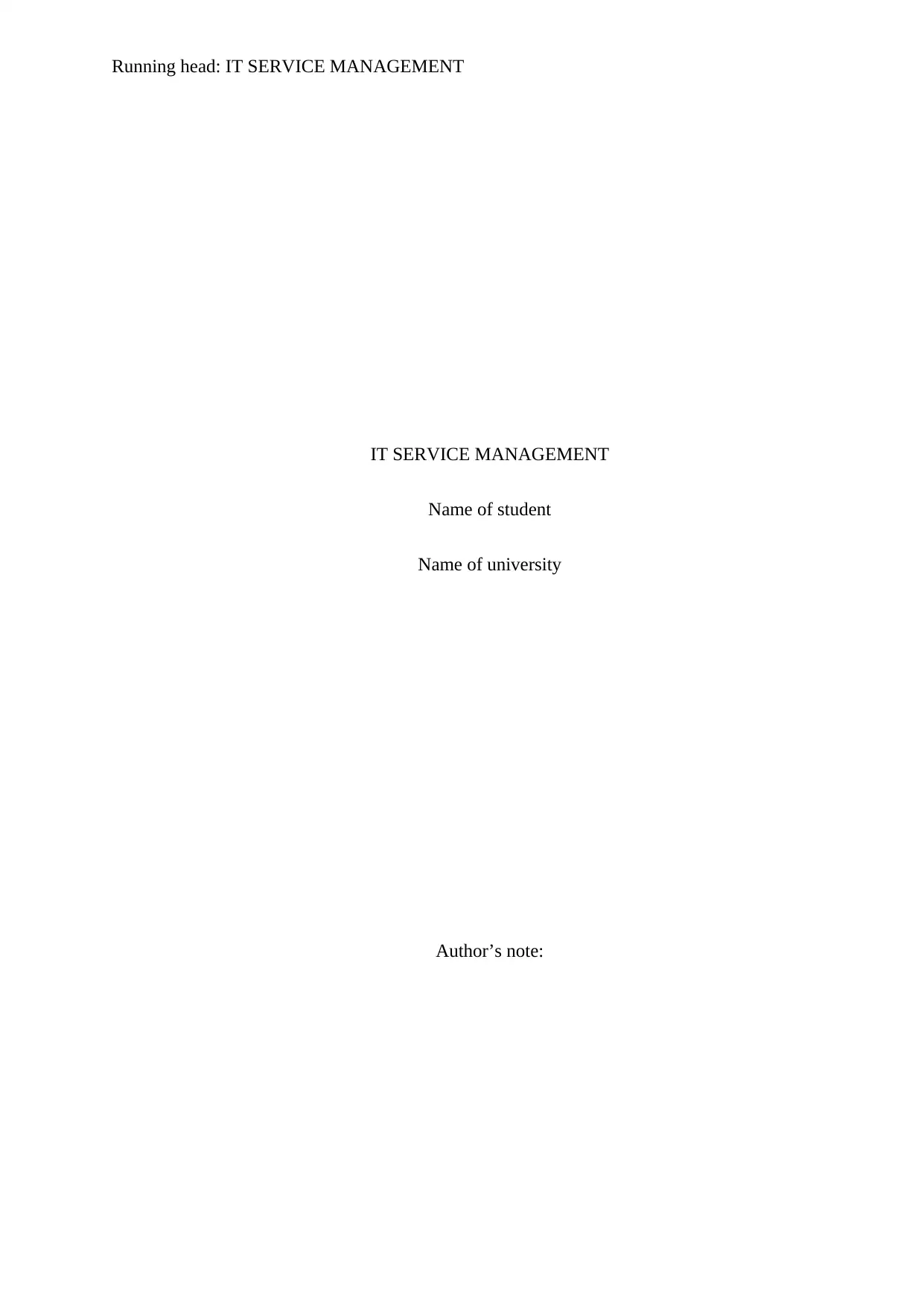
Running head: IT SERVICE MANAGEMENT
IT SERVICE MANAGEMENT
Name of student
Name of university
Author’s note:
IT SERVICE MANAGEMENT
Name of student
Name of university
Author’s note:
Secure Best Marks with AI Grader
Need help grading? Try our AI Grader for instant feedback on your assignments.
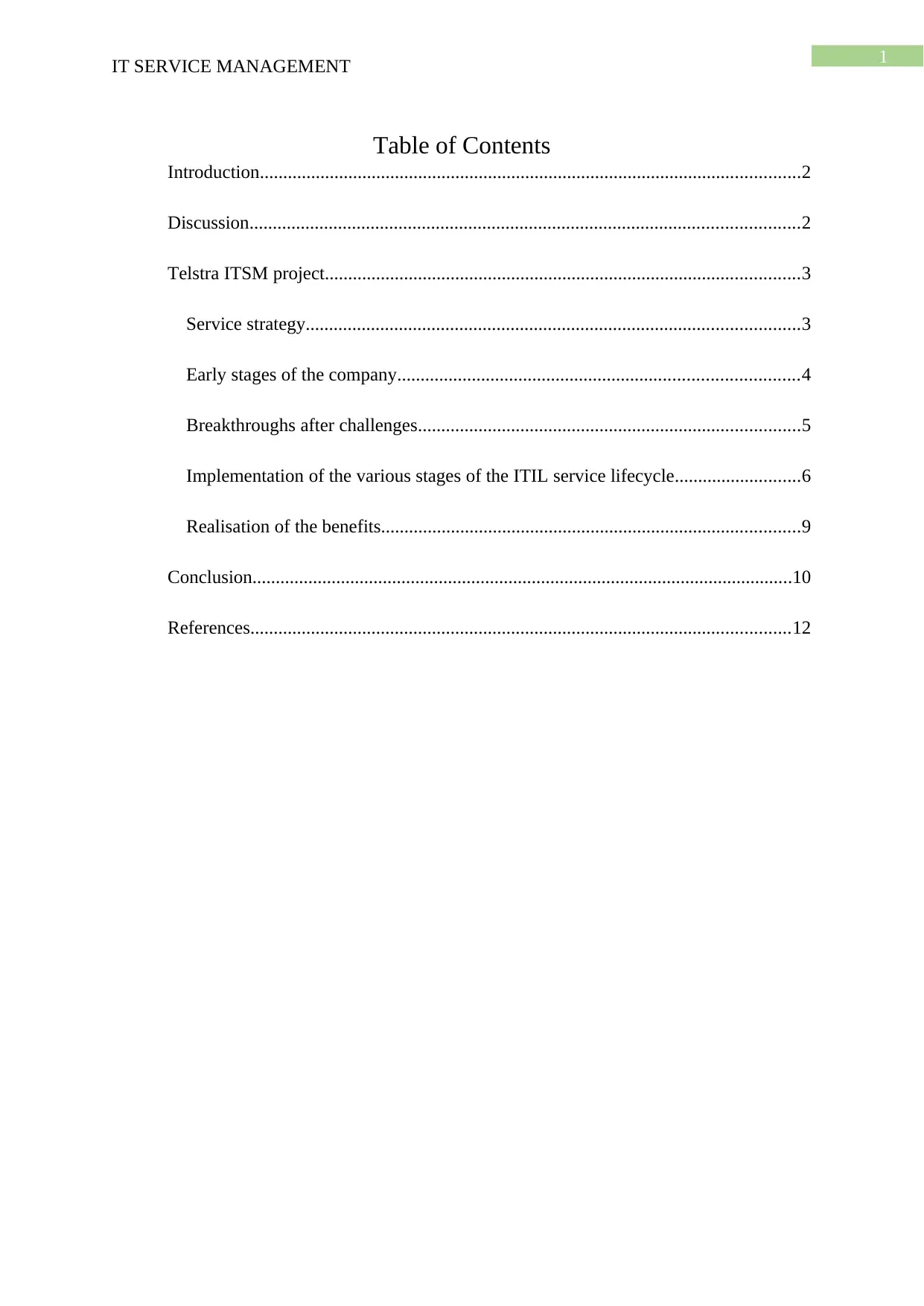
1
IT SERVICE MANAGEMENT
Table of Contents
Introduction....................................................................................................................2
Discussion......................................................................................................................2
Telstra ITSM project......................................................................................................3
Service strategy..........................................................................................................3
Early stages of the company......................................................................................4
Breakthroughs after challenges..................................................................................5
Implementation of the various stages of the ITIL service lifecycle...........................6
Realisation of the benefits..........................................................................................9
Conclusion....................................................................................................................10
References....................................................................................................................12
IT SERVICE MANAGEMENT
Table of Contents
Introduction....................................................................................................................2
Discussion......................................................................................................................2
Telstra ITSM project......................................................................................................3
Service strategy..........................................................................................................3
Early stages of the company......................................................................................4
Breakthroughs after challenges..................................................................................5
Implementation of the various stages of the ITIL service lifecycle...........................6
Realisation of the benefits..........................................................................................9
Conclusion....................................................................................................................10
References....................................................................................................................12
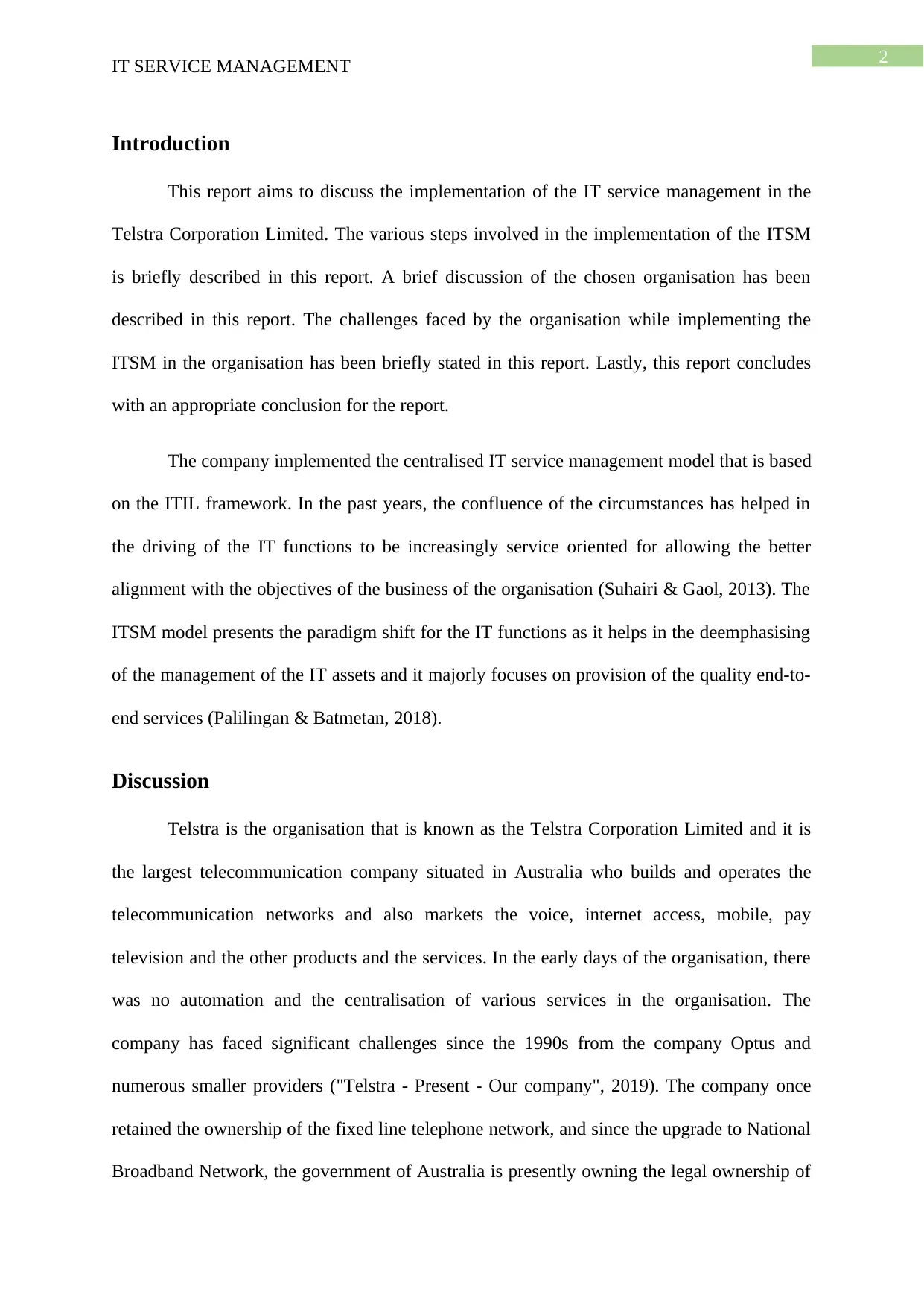
2
IT SERVICE MANAGEMENT
Introduction
This report aims to discuss the implementation of the IT service management in the
Telstra Corporation Limited. The various steps involved in the implementation of the ITSM
is briefly described in this report. A brief discussion of the chosen organisation has been
described in this report. The challenges faced by the organisation while implementing the
ITSM in the organisation has been briefly stated in this report. Lastly, this report concludes
with an appropriate conclusion for the report.
The company implemented the centralised IT service management model that is based
on the ITIL framework. In the past years, the confluence of the circumstances has helped in
the driving of the IT functions to be increasingly service oriented for allowing the better
alignment with the objectives of the business of the organisation (Suhairi & Gaol, 2013). The
ITSM model presents the paradigm shift for the IT functions as it helps in the deemphasising
of the management of the IT assets and it majorly focuses on provision of the quality end-to-
end services (Palilingan & Batmetan, 2018).
Discussion
Telstra is the organisation that is known as the Telstra Corporation Limited and it is
the largest telecommunication company situated in Australia who builds and operates the
telecommunication networks and also markets the voice, internet access, mobile, pay
television and the other products and the services. In the early days of the organisation, there
was no automation and the centralisation of various services in the organisation. The
company has faced significant challenges since the 1990s from the company Optus and
numerous smaller providers ("Telstra - Present - Our company", 2019). The company once
retained the ownership of the fixed line telephone network, and since the upgrade to National
Broadband Network, the government of Australia is presently owning the legal ownership of
IT SERVICE MANAGEMENT
Introduction
This report aims to discuss the implementation of the IT service management in the
Telstra Corporation Limited. The various steps involved in the implementation of the ITSM
is briefly described in this report. A brief discussion of the chosen organisation has been
described in this report. The challenges faced by the organisation while implementing the
ITSM in the organisation has been briefly stated in this report. Lastly, this report concludes
with an appropriate conclusion for the report.
The company implemented the centralised IT service management model that is based
on the ITIL framework. In the past years, the confluence of the circumstances has helped in
the driving of the IT functions to be increasingly service oriented for allowing the better
alignment with the objectives of the business of the organisation (Suhairi & Gaol, 2013). The
ITSM model presents the paradigm shift for the IT functions as it helps in the deemphasising
of the management of the IT assets and it majorly focuses on provision of the quality end-to-
end services (Palilingan & Batmetan, 2018).
Discussion
Telstra is the organisation that is known as the Telstra Corporation Limited and it is
the largest telecommunication company situated in Australia who builds and operates the
telecommunication networks and also markets the voice, internet access, mobile, pay
television and the other products and the services. In the early days of the organisation, there
was no automation and the centralisation of various services in the organisation. The
company has faced significant challenges since the 1990s from the company Optus and
numerous smaller providers ("Telstra - Present - Our company", 2019). The company once
retained the ownership of the fixed line telephone network, and since the upgrade to National
Broadband Network, the government of Australia is presently owning the legal ownership of
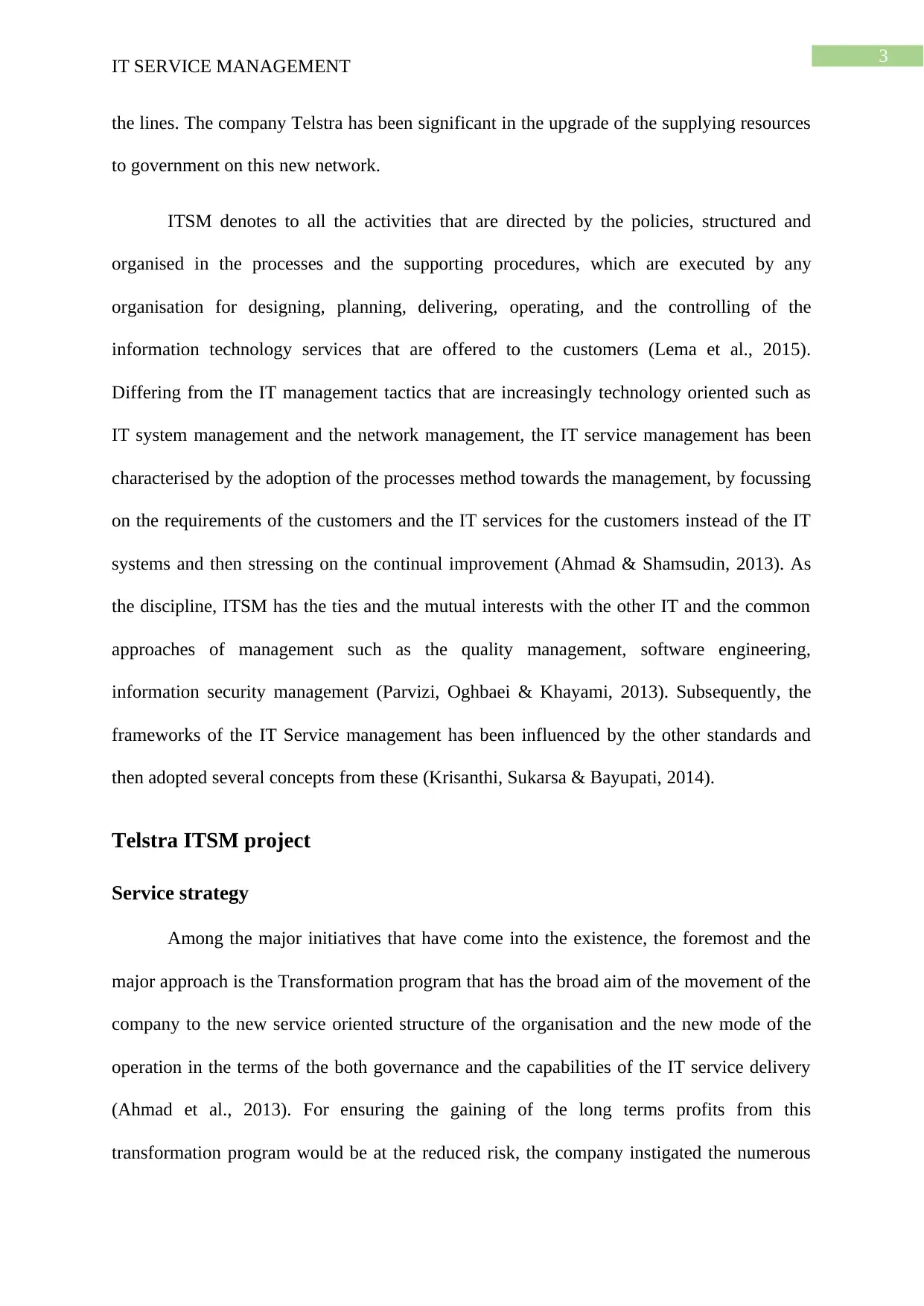
3
IT SERVICE MANAGEMENT
the lines. The company Telstra has been significant in the upgrade of the supplying resources
to government on this new network.
ITSM denotes to all the activities that are directed by the policies, structured and
organised in the processes and the supporting procedures, which are executed by any
organisation for designing, planning, delivering, operating, and the controlling of the
information technology services that are offered to the customers (Lema et al., 2015).
Differing from the IT management tactics that are increasingly technology oriented such as
IT system management and the network management, the IT service management has been
characterised by the adoption of the processes method towards the management, by focussing
on the requirements of the customers and the IT services for the customers instead of the IT
systems and then stressing on the continual improvement (Ahmad & Shamsudin, 2013). As
the discipline, ITSM has the ties and the mutual interests with the other IT and the common
approaches of management such as the quality management, software engineering,
information security management (Parvizi, Oghbaei & Khayami, 2013). Subsequently, the
frameworks of the IT Service management has been influenced by the other standards and
then adopted several concepts from these (Krisanthi, Sukarsa & Bayupati, 2014).
Telstra ITSM project
Service strategy
Among the major initiatives that have come into the existence, the foremost and the
major approach is the Transformation program that has the broad aim of the movement of the
company to the new service oriented structure of the organisation and the new mode of the
operation in the terms of the both governance and the capabilities of the IT service delivery
(Ahmad et al., 2013). For ensuring the gaining of the long terms profits from this
transformation program would be at the reduced risk, the company instigated the numerous
IT SERVICE MANAGEMENT
the lines. The company Telstra has been significant in the upgrade of the supplying resources
to government on this new network.
ITSM denotes to all the activities that are directed by the policies, structured and
organised in the processes and the supporting procedures, which are executed by any
organisation for designing, planning, delivering, operating, and the controlling of the
information technology services that are offered to the customers (Lema et al., 2015).
Differing from the IT management tactics that are increasingly technology oriented such as
IT system management and the network management, the IT service management has been
characterised by the adoption of the processes method towards the management, by focussing
on the requirements of the customers and the IT services for the customers instead of the IT
systems and then stressing on the continual improvement (Ahmad & Shamsudin, 2013). As
the discipline, ITSM has the ties and the mutual interests with the other IT and the common
approaches of management such as the quality management, software engineering,
information security management (Parvizi, Oghbaei & Khayami, 2013). Subsequently, the
frameworks of the IT Service management has been influenced by the other standards and
then adopted several concepts from these (Krisanthi, Sukarsa & Bayupati, 2014).
Telstra ITSM project
Service strategy
Among the major initiatives that have come into the existence, the foremost and the
major approach is the Transformation program that has the broad aim of the movement of the
company to the new service oriented structure of the organisation and the new mode of the
operation in the terms of the both governance and the capabilities of the IT service delivery
(Ahmad et al., 2013). For ensuring the gaining of the long terms profits from this
transformation program would be at the reduced risk, the company instigated the numerous
Secure Best Marks with AI Grader
Need help grading? Try our AI Grader for instant feedback on your assignments.
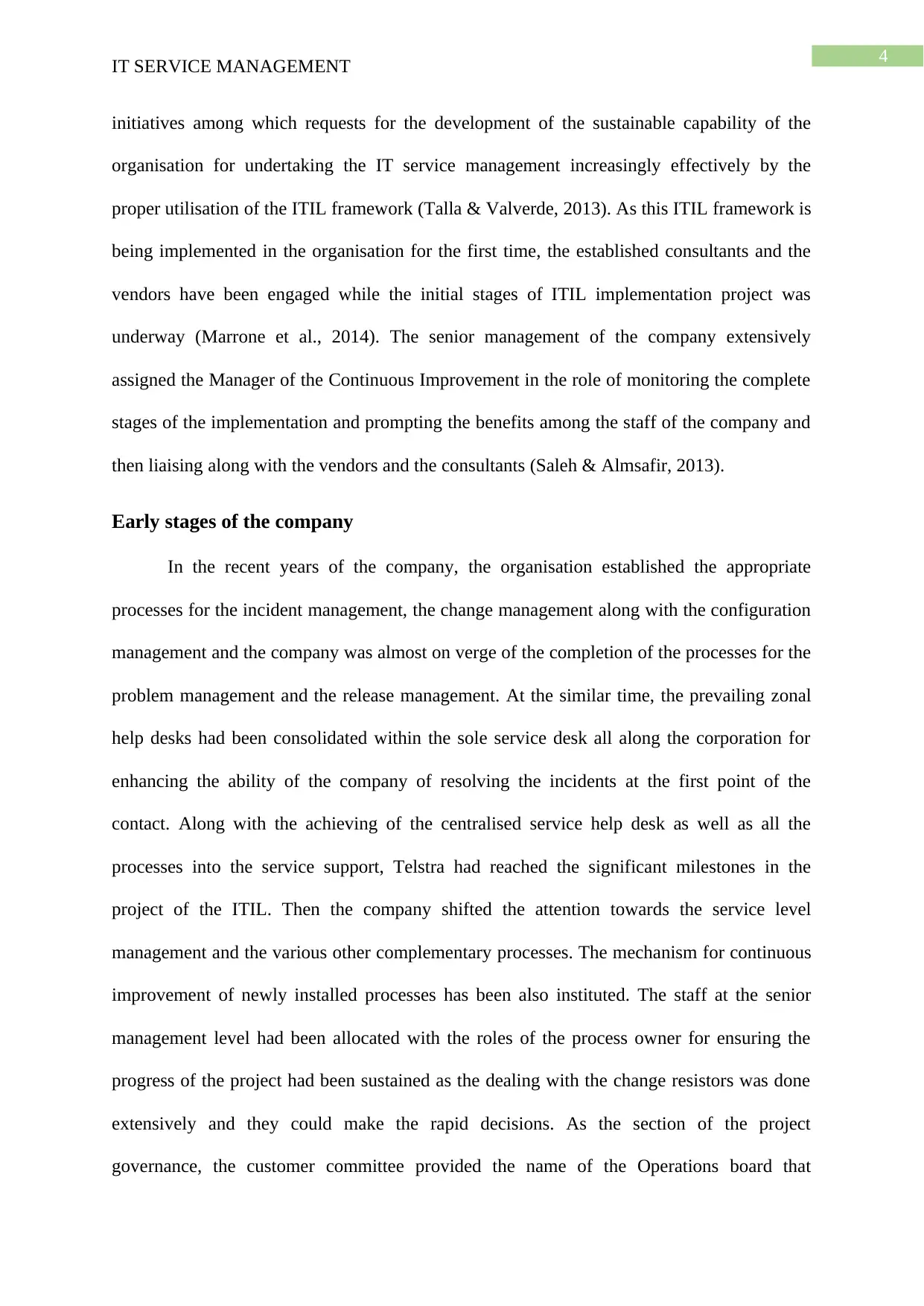
4
IT SERVICE MANAGEMENT
initiatives among which requests for the development of the sustainable capability of the
organisation for undertaking the IT service management increasingly effectively by the
proper utilisation of the ITIL framework (Talla & Valverde, 2013). As this ITIL framework is
being implemented in the organisation for the first time, the established consultants and the
vendors have been engaged while the initial stages of ITIL implementation project was
underway (Marrone et al., 2014). The senior management of the company extensively
assigned the Manager of the Continuous Improvement in the role of monitoring the complete
stages of the implementation and prompting the benefits among the staff of the company and
then liaising along with the vendors and the consultants (Saleh & Almsafir, 2013).
Early stages of the company
In the recent years of the company, the organisation established the appropriate
processes for the incident management, the change management along with the configuration
management and the company was almost on verge of the completion of the processes for the
problem management and the release management. At the similar time, the prevailing zonal
help desks had been consolidated within the sole service desk all along the corporation for
enhancing the ability of the company of resolving the incidents at the first point of the
contact. Along with the achieving of the centralised service help desk as well as all the
processes into the service support, Telstra had reached the significant milestones in the
project of the ITIL. Then the company shifted the attention towards the service level
management and the various other complementary processes. The mechanism for continuous
improvement of newly installed processes has been also instituted. The staff at the senior
management level had been allocated with the roles of the process owner for ensuring the
progress of the project had been sustained as the dealing with the change resistors was done
extensively and they could make the rapid decisions. As the section of the project
governance, the customer committee provided the name of the Operations board that
IT SERVICE MANAGEMENT
initiatives among which requests for the development of the sustainable capability of the
organisation for undertaking the IT service management increasingly effectively by the
proper utilisation of the ITIL framework (Talla & Valverde, 2013). As this ITIL framework is
being implemented in the organisation for the first time, the established consultants and the
vendors have been engaged while the initial stages of ITIL implementation project was
underway (Marrone et al., 2014). The senior management of the company extensively
assigned the Manager of the Continuous Improvement in the role of monitoring the complete
stages of the implementation and prompting the benefits among the staff of the company and
then liaising along with the vendors and the consultants (Saleh & Almsafir, 2013).
Early stages of the company
In the recent years of the company, the organisation established the appropriate
processes for the incident management, the change management along with the configuration
management and the company was almost on verge of the completion of the processes for the
problem management and the release management. At the similar time, the prevailing zonal
help desks had been consolidated within the sole service desk all along the corporation for
enhancing the ability of the company of resolving the incidents at the first point of the
contact. Along with the achieving of the centralised service help desk as well as all the
processes into the service support, Telstra had reached the significant milestones in the
project of the ITIL. Then the company shifted the attention towards the service level
management and the various other complementary processes. The mechanism for continuous
improvement of newly installed processes has been also instituted. The staff at the senior
management level had been allocated with the roles of the process owner for ensuring the
progress of the project had been sustained as the dealing with the change resistors was done
extensively and they could make the rapid decisions. As the section of the project
governance, the customer committee provided the name of the Operations board that
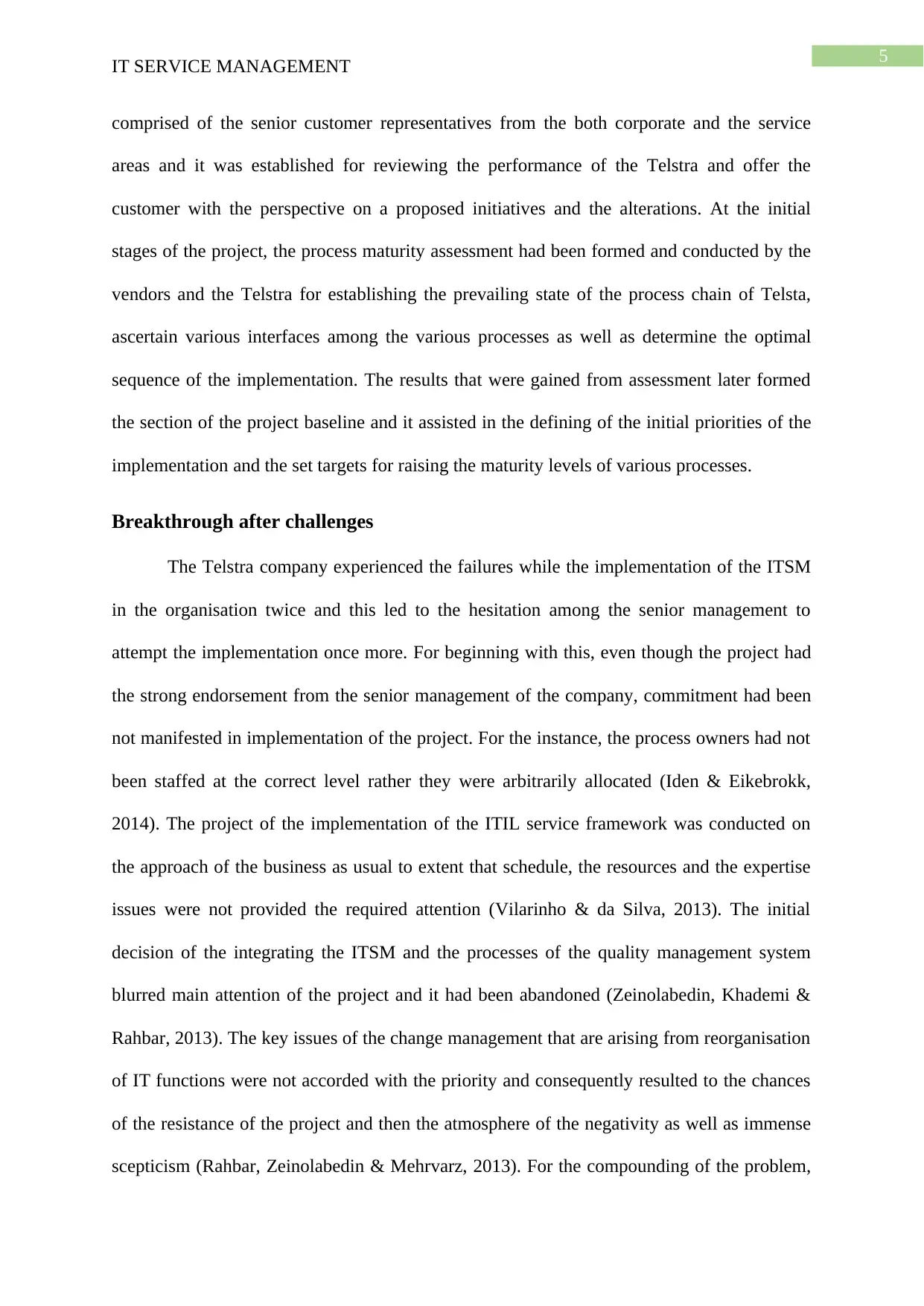
5
IT SERVICE MANAGEMENT
comprised of the senior customer representatives from the both corporate and the service
areas and it was established for reviewing the performance of the Telstra and offer the
customer with the perspective on a proposed initiatives and the alterations. At the initial
stages of the project, the process maturity assessment had been formed and conducted by the
vendors and the Telstra for establishing the prevailing state of the process chain of Telsta,
ascertain various interfaces among the various processes as well as determine the optimal
sequence of the implementation. The results that were gained from assessment later formed
the section of the project baseline and it assisted in the defining of the initial priorities of the
implementation and the set targets for raising the maturity levels of various processes.
Breakthrough after challenges
The Telstra company experienced the failures while the implementation of the ITSM
in the organisation twice and this led to the hesitation among the senior management to
attempt the implementation once more. For beginning with this, even though the project had
the strong endorsement from the senior management of the company, commitment had been
not manifested in implementation of the project. For the instance, the process owners had not
been staffed at the correct level rather they were arbitrarily allocated (Iden & Eikebrokk,
2014). The project of the implementation of the ITIL service framework was conducted on
the approach of the business as usual to extent that schedule, the resources and the expertise
issues were not provided the required attention (Vilarinho & da Silva, 2013). The initial
decision of the integrating the ITSM and the processes of the quality management system
blurred main attention of the project and it had been abandoned (Zeinolabedin, Khademi &
Rahbar, 2013). The key issues of the change management that are arising from reorganisation
of IT functions were not accorded with the priority and consequently resulted to the chances
of the resistance of the project and then the atmosphere of the negativity as well as immense
scepticism (Rahbar, Zeinolabedin & Mehrvarz, 2013). For the compounding of the problem,
IT SERVICE MANAGEMENT
comprised of the senior customer representatives from the both corporate and the service
areas and it was established for reviewing the performance of the Telstra and offer the
customer with the perspective on a proposed initiatives and the alterations. At the initial
stages of the project, the process maturity assessment had been formed and conducted by the
vendors and the Telstra for establishing the prevailing state of the process chain of Telsta,
ascertain various interfaces among the various processes as well as determine the optimal
sequence of the implementation. The results that were gained from assessment later formed
the section of the project baseline and it assisted in the defining of the initial priorities of the
implementation and the set targets for raising the maturity levels of various processes.
Breakthrough after challenges
The Telstra company experienced the failures while the implementation of the ITSM
in the organisation twice and this led to the hesitation among the senior management to
attempt the implementation once more. For beginning with this, even though the project had
the strong endorsement from the senior management of the company, commitment had been
not manifested in implementation of the project. For the instance, the process owners had not
been staffed at the correct level rather they were arbitrarily allocated (Iden & Eikebrokk,
2014). The project of the implementation of the ITIL service framework was conducted on
the approach of the business as usual to extent that schedule, the resources and the expertise
issues were not provided the required attention (Vilarinho & da Silva, 2013). The initial
decision of the integrating the ITSM and the processes of the quality management system
blurred main attention of the project and it had been abandoned (Zeinolabedin, Khademi &
Rahbar, 2013). The key issues of the change management that are arising from reorganisation
of IT functions were not accorded with the priority and consequently resulted to the chances
of the resistance of the project and then the atmosphere of the negativity as well as immense
scepticism (Rahbar, Zeinolabedin & Mehrvarz, 2013). For the compounding of the problem,
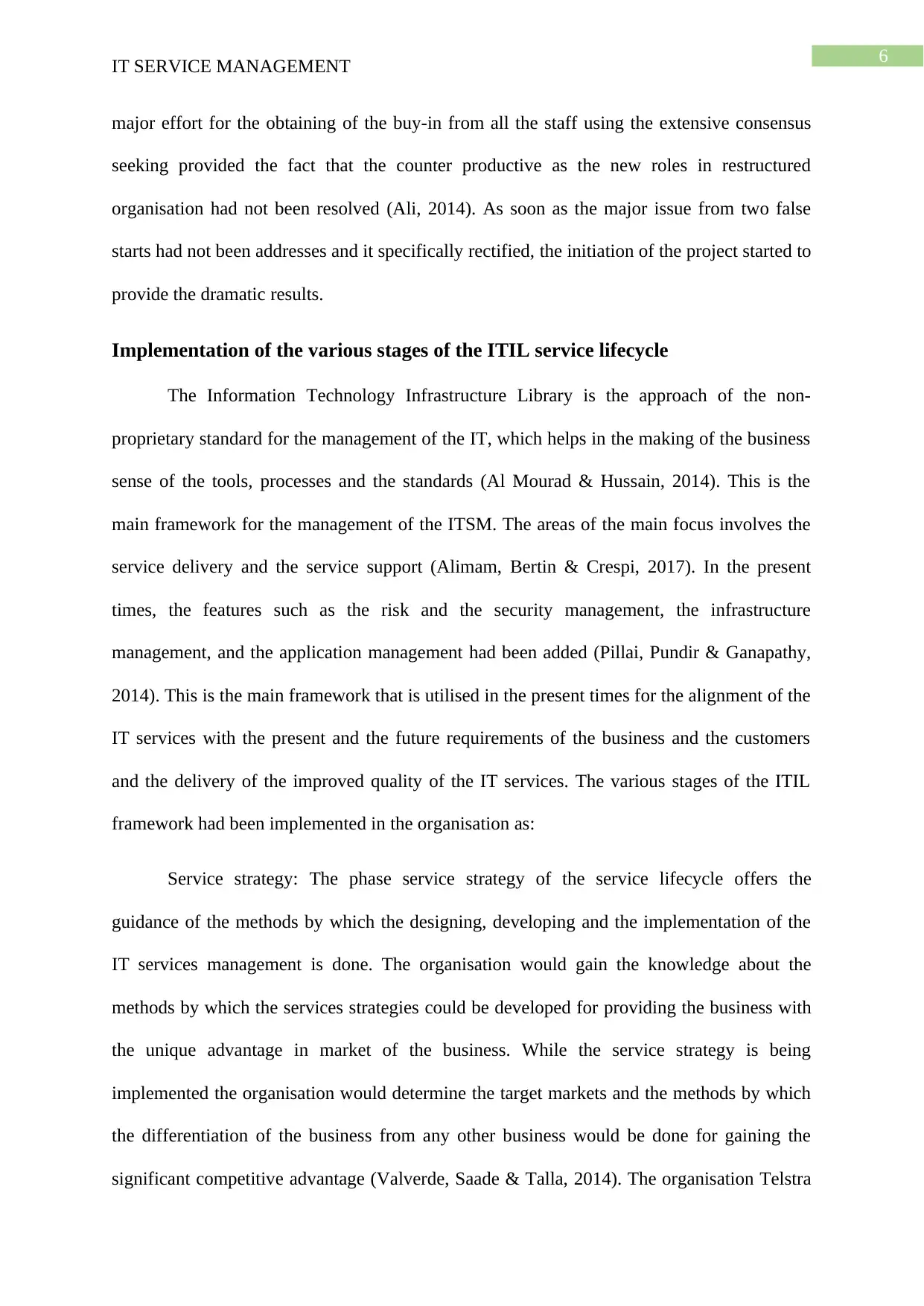
6
IT SERVICE MANAGEMENT
major effort for the obtaining of the buy-in from all the staff using the extensive consensus
seeking provided the fact that the counter productive as the new roles in restructured
organisation had not been resolved (Ali, 2014). As soon as the major issue from two false
starts had not been addresses and it specifically rectified, the initiation of the project started to
provide the dramatic results.
Implementation of the various stages of the ITIL service lifecycle
The Information Technology Infrastructure Library is the approach of the non-
proprietary standard for the management of the IT, which helps in the making of the business
sense of the tools, processes and the standards (Al Mourad & Hussain, 2014). This is the
main framework for the management of the ITSM. The areas of the main focus involves the
service delivery and the service support (Alimam, Bertin & Crespi, 2017). In the present
times, the features such as the risk and the security management, the infrastructure
management, and the application management had been added (Pillai, Pundir & Ganapathy,
2014). This is the main framework that is utilised in the present times for the alignment of the
IT services with the present and the future requirements of the business and the customers
and the delivery of the improved quality of the IT services. The various stages of the ITIL
framework had been implemented in the organisation as:
Service strategy: The phase service strategy of the service lifecycle offers the
guidance of the methods by which the designing, developing and the implementation of the
IT services management is done. The organisation would gain the knowledge about the
methods by which the services strategies could be developed for providing the business with
the unique advantage in market of the business. While the service strategy is being
implemented the organisation would determine the target markets and the methods by which
the differentiation of the business from any other business would be done for gaining the
significant competitive advantage (Valverde, Saade & Talla, 2014). The organisation Telstra
IT SERVICE MANAGEMENT
major effort for the obtaining of the buy-in from all the staff using the extensive consensus
seeking provided the fact that the counter productive as the new roles in restructured
organisation had not been resolved (Ali, 2014). As soon as the major issue from two false
starts had not been addresses and it specifically rectified, the initiation of the project started to
provide the dramatic results.
Implementation of the various stages of the ITIL service lifecycle
The Information Technology Infrastructure Library is the approach of the non-
proprietary standard for the management of the IT, which helps in the making of the business
sense of the tools, processes and the standards (Al Mourad & Hussain, 2014). This is the
main framework for the management of the ITSM. The areas of the main focus involves the
service delivery and the service support (Alimam, Bertin & Crespi, 2017). In the present
times, the features such as the risk and the security management, the infrastructure
management, and the application management had been added (Pillai, Pundir & Ganapathy,
2014). This is the main framework that is utilised in the present times for the alignment of the
IT services with the present and the future requirements of the business and the customers
and the delivery of the improved quality of the IT services. The various stages of the ITIL
framework had been implemented in the organisation as:
Service strategy: The phase service strategy of the service lifecycle offers the
guidance of the methods by which the designing, developing and the implementation of the
IT services management is done. The organisation would gain the knowledge about the
methods by which the services strategies could be developed for providing the business with
the unique advantage in market of the business. While the service strategy is being
implemented the organisation would determine the target markets and the methods by which
the differentiation of the business from any other business would be done for gaining the
significant competitive advantage (Valverde, Saade & Talla, 2014). The organisation Telstra
Paraphrase This Document
Need a fresh take? Get an instant paraphrase of this document with our AI Paraphraser
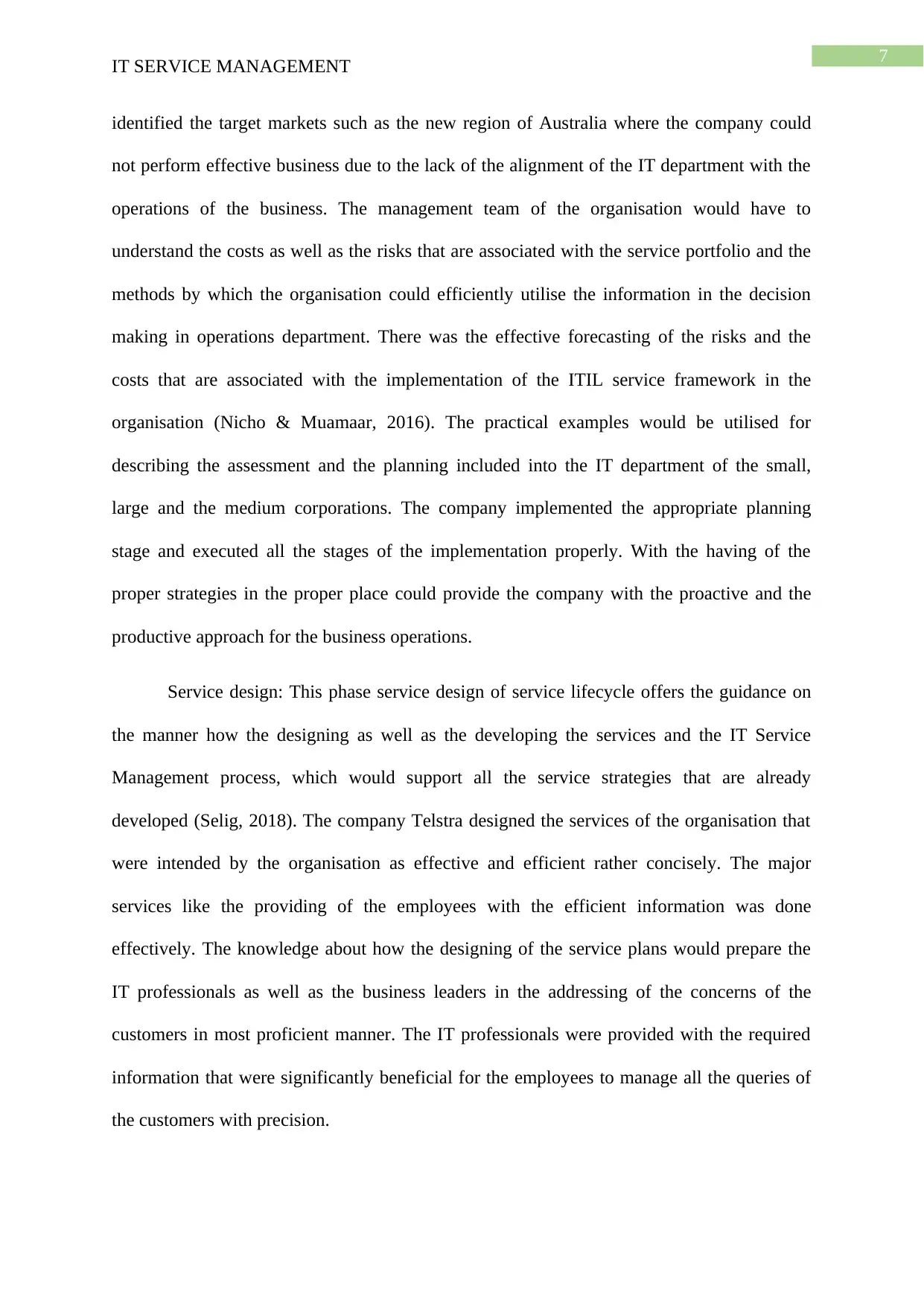
7
IT SERVICE MANAGEMENT
identified the target markets such as the new region of Australia where the company could
not perform effective business due to the lack of the alignment of the IT department with the
operations of the business. The management team of the organisation would have to
understand the costs as well as the risks that are associated with the service portfolio and the
methods by which the organisation could efficiently utilise the information in the decision
making in operations department. There was the effective forecasting of the risks and the
costs that are associated with the implementation of the ITIL service framework in the
organisation (Nicho & Muamaar, 2016). The practical examples would be utilised for
describing the assessment and the planning included into the IT department of the small,
large and the medium corporations. The company implemented the appropriate planning
stage and executed all the stages of the implementation properly. With the having of the
proper strategies in the proper place could provide the company with the proactive and the
productive approach for the business operations.
Service design: This phase service design of service lifecycle offers the guidance on
the manner how the designing as well as the developing the services and the IT Service
Management process, which would support all the service strategies that are already
developed (Selig, 2018). The company Telstra designed the services of the organisation that
were intended by the organisation as effective and efficient rather concisely. The major
services like the providing of the employees with the efficient information was done
effectively. The knowledge about how the designing of the service plans would prepare the
IT professionals as well as the business leaders in the addressing of the concerns of the
customers in most proficient manner. The IT professionals were provided with the required
information that were significantly beneficial for the employees to manage all the queries of
the customers with precision.
IT SERVICE MANAGEMENT
identified the target markets such as the new region of Australia where the company could
not perform effective business due to the lack of the alignment of the IT department with the
operations of the business. The management team of the organisation would have to
understand the costs as well as the risks that are associated with the service portfolio and the
methods by which the organisation could efficiently utilise the information in the decision
making in operations department. There was the effective forecasting of the risks and the
costs that are associated with the implementation of the ITIL service framework in the
organisation (Nicho & Muamaar, 2016). The practical examples would be utilised for
describing the assessment and the planning included into the IT department of the small,
large and the medium corporations. The company implemented the appropriate planning
stage and executed all the stages of the implementation properly. With the having of the
proper strategies in the proper place could provide the company with the proactive and the
productive approach for the business operations.
Service design: This phase service design of service lifecycle offers the guidance on
the manner how the designing as well as the developing the services and the IT Service
Management process, which would support all the service strategies that are already
developed (Selig, 2018). The company Telstra designed the services of the organisation that
were intended by the organisation as effective and efficient rather concisely. The major
services like the providing of the employees with the efficient information was done
effectively. The knowledge about how the designing of the service plans would prepare the
IT professionals as well as the business leaders in the addressing of the concerns of the
customers in most proficient manner. The IT professionals were provided with the required
information that were significantly beneficial for the employees to manage all the queries of
the customers with precision.
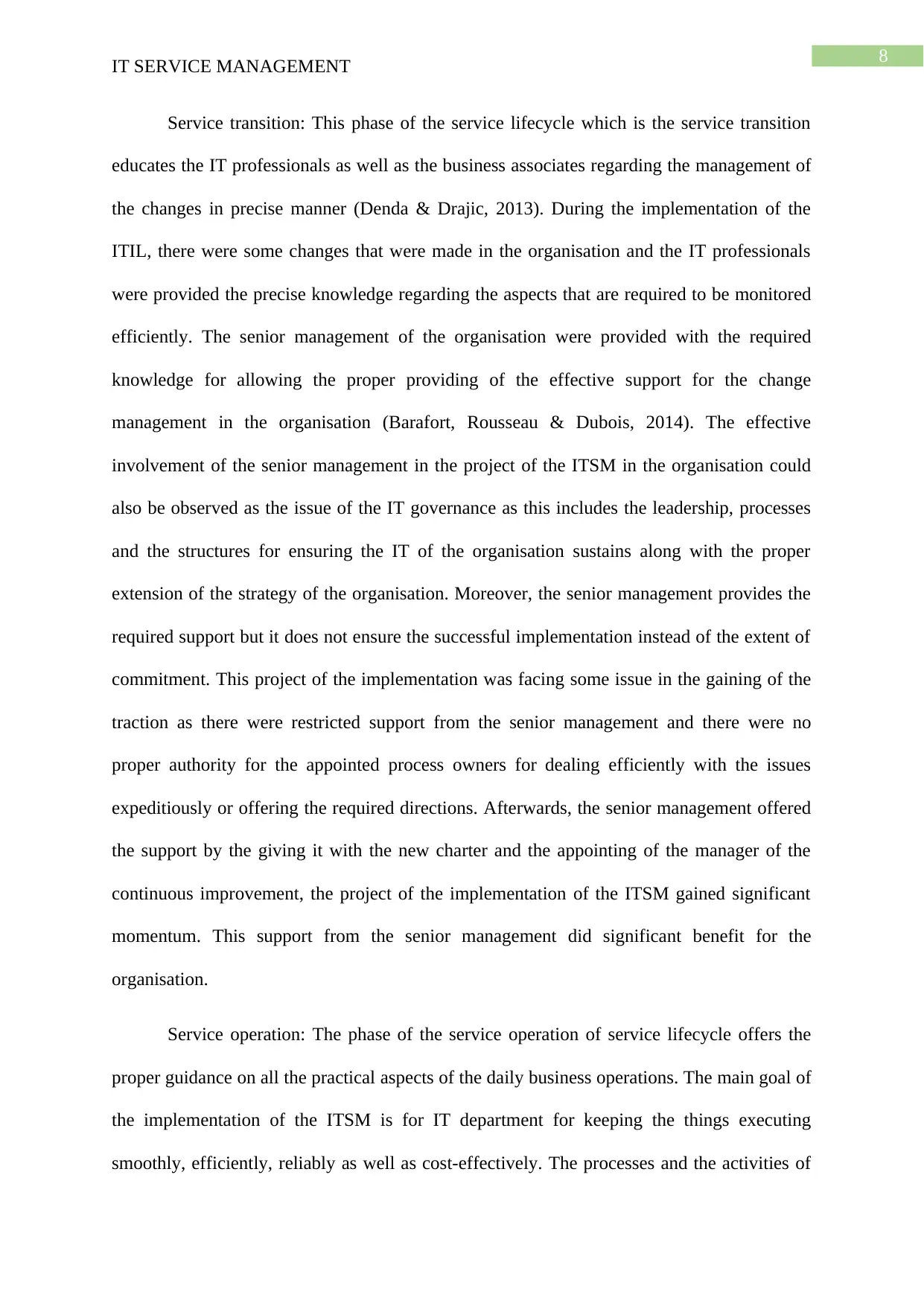
8
IT SERVICE MANAGEMENT
Service transition: This phase of the service lifecycle which is the service transition
educates the IT professionals as well as the business associates regarding the management of
the changes in precise manner (Denda & Drajic, 2013). During the implementation of the
ITIL, there were some changes that were made in the organisation and the IT professionals
were provided the precise knowledge regarding the aspects that are required to be monitored
efficiently. The senior management of the organisation were provided with the required
knowledge for allowing the proper providing of the effective support for the change
management in the organisation (Barafort, Rousseau & Dubois, 2014). The effective
involvement of the senior management in the project of the ITSM in the organisation could
also be observed as the issue of the IT governance as this includes the leadership, processes
and the structures for ensuring the IT of the organisation sustains along with the proper
extension of the strategy of the organisation. Moreover, the senior management provides the
required support but it does not ensure the successful implementation instead of the extent of
commitment. This project of the implementation was facing some issue in the gaining of the
traction as there were restricted support from the senior management and there were no
proper authority for the appointed process owners for dealing efficiently with the issues
expeditiously or offering the required directions. Afterwards, the senior management offered
the support by the giving it with the new charter and the appointing of the manager of the
continuous improvement, the project of the implementation of the ITSM gained significant
momentum. This support from the senior management did significant benefit for the
organisation.
Service operation: The phase of the service operation of service lifecycle offers the
proper guidance on all the practical aspects of the daily business operations. The main goal of
the implementation of the ITSM is for IT department for keeping the things executing
smoothly, efficiently, reliably as well as cost-effectively. The processes and the activities of
IT SERVICE MANAGEMENT
Service transition: This phase of the service lifecycle which is the service transition
educates the IT professionals as well as the business associates regarding the management of
the changes in precise manner (Denda & Drajic, 2013). During the implementation of the
ITIL, there were some changes that were made in the organisation and the IT professionals
were provided the precise knowledge regarding the aspects that are required to be monitored
efficiently. The senior management of the organisation were provided with the required
knowledge for allowing the proper providing of the effective support for the change
management in the organisation (Barafort, Rousseau & Dubois, 2014). The effective
involvement of the senior management in the project of the ITSM in the organisation could
also be observed as the issue of the IT governance as this includes the leadership, processes
and the structures for ensuring the IT of the organisation sustains along with the proper
extension of the strategy of the organisation. Moreover, the senior management provides the
required support but it does not ensure the successful implementation instead of the extent of
commitment. This project of the implementation was facing some issue in the gaining of the
traction as there were restricted support from the senior management and there were no
proper authority for the appointed process owners for dealing efficiently with the issues
expeditiously or offering the required directions. Afterwards, the senior management offered
the support by the giving it with the new charter and the appointing of the manager of the
continuous improvement, the project of the implementation of the ITSM gained significant
momentum. This support from the senior management did significant benefit for the
organisation.
Service operation: The phase of the service operation of service lifecycle offers the
proper guidance on all the practical aspects of the daily business operations. The main goal of
the implementation of the ITSM is for IT department for keeping the things executing
smoothly, efficiently, reliably as well as cost-effectively. The processes and the activities of
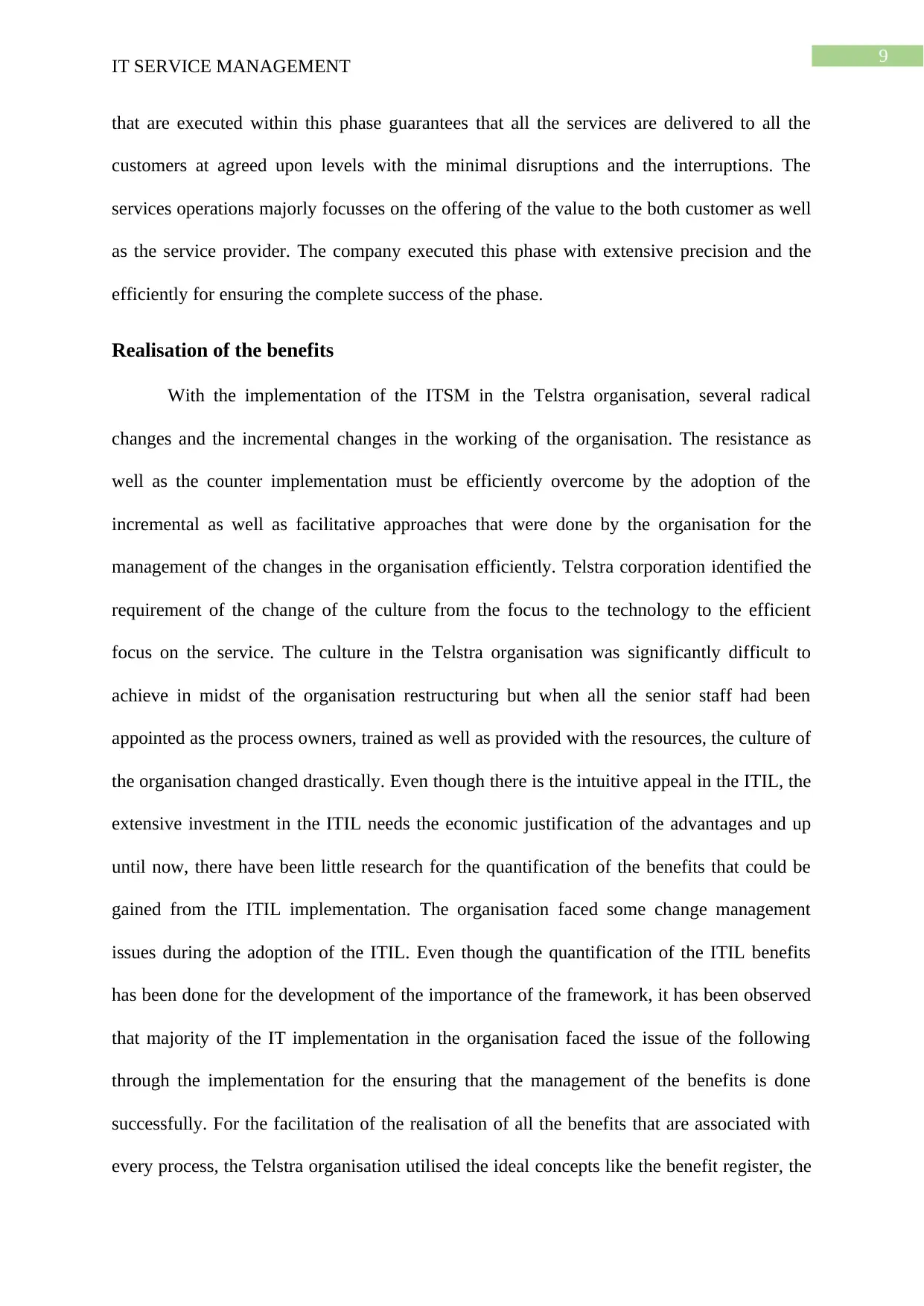
9
IT SERVICE MANAGEMENT
that are executed within this phase guarantees that all the services are delivered to all the
customers at agreed upon levels with the minimal disruptions and the interruptions. The
services operations majorly focusses on the offering of the value to the both customer as well
as the service provider. The company executed this phase with extensive precision and the
efficiently for ensuring the complete success of the phase.
Realisation of the benefits
With the implementation of the ITSM in the Telstra organisation, several radical
changes and the incremental changes in the working of the organisation. The resistance as
well as the counter implementation must be efficiently overcome by the adoption of the
incremental as well as facilitative approaches that were done by the organisation for the
management of the changes in the organisation efficiently. Telstra corporation identified the
requirement of the change of the culture from the focus to the technology to the efficient
focus on the service. The culture in the Telstra organisation was significantly difficult to
achieve in midst of the organisation restructuring but when all the senior staff had been
appointed as the process owners, trained as well as provided with the resources, the culture of
the organisation changed drastically. Even though there is the intuitive appeal in the ITIL, the
extensive investment in the ITIL needs the economic justification of the advantages and up
until now, there have been little research for the quantification of the benefits that could be
gained from the ITIL implementation. The organisation faced some change management
issues during the adoption of the ITIL. Even though the quantification of the ITIL benefits
has been done for the development of the importance of the framework, it has been observed
that majority of the IT implementation in the organisation faced the issue of the following
through the implementation for the ensuring that the management of the benefits is done
successfully. For the facilitation of the realisation of all the benefits that are associated with
every process, the Telstra organisation utilised the ideal concepts like the benefit register, the
IT SERVICE MANAGEMENT
that are executed within this phase guarantees that all the services are delivered to all the
customers at agreed upon levels with the minimal disruptions and the interruptions. The
services operations majorly focusses on the offering of the value to the both customer as well
as the service provider. The company executed this phase with extensive precision and the
efficiently for ensuring the complete success of the phase.
Realisation of the benefits
With the implementation of the ITSM in the Telstra organisation, several radical
changes and the incremental changes in the working of the organisation. The resistance as
well as the counter implementation must be efficiently overcome by the adoption of the
incremental as well as facilitative approaches that were done by the organisation for the
management of the changes in the organisation efficiently. Telstra corporation identified the
requirement of the change of the culture from the focus to the technology to the efficient
focus on the service. The culture in the Telstra organisation was significantly difficult to
achieve in midst of the organisation restructuring but when all the senior staff had been
appointed as the process owners, trained as well as provided with the resources, the culture of
the organisation changed drastically. Even though there is the intuitive appeal in the ITIL, the
extensive investment in the ITIL needs the economic justification of the advantages and up
until now, there have been little research for the quantification of the benefits that could be
gained from the ITIL implementation. The organisation faced some change management
issues during the adoption of the ITIL. Even though the quantification of the ITIL benefits
has been done for the development of the importance of the framework, it has been observed
that majority of the IT implementation in the organisation faced the issue of the following
through the implementation for the ensuring that the management of the benefits is done
successfully. For the facilitation of the realisation of all the benefits that are associated with
every process, the Telstra organisation utilised the ideal concepts like the benefit register, the
Secure Best Marks with AI Grader
Need help grading? Try our AI Grader for instant feedback on your assignments.
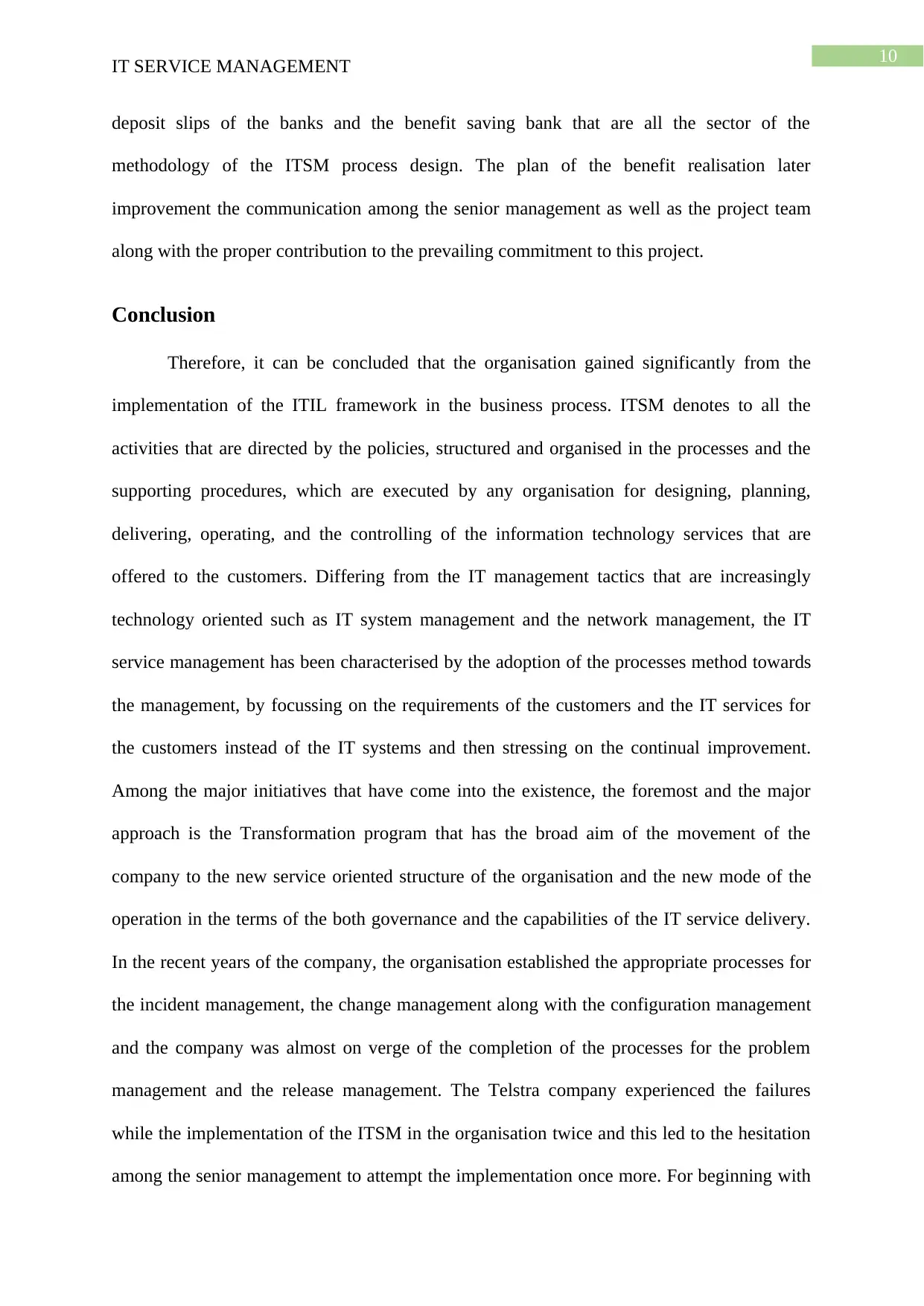
10
IT SERVICE MANAGEMENT
deposit slips of the banks and the benefit saving bank that are all the sector of the
methodology of the ITSM process design. The plan of the benefit realisation later
improvement the communication among the senior management as well as the project team
along with the proper contribution to the prevailing commitment to this project.
Conclusion
Therefore, it can be concluded that the organisation gained significantly from the
implementation of the ITIL framework in the business process. ITSM denotes to all the
activities that are directed by the policies, structured and organised in the processes and the
supporting procedures, which are executed by any organisation for designing, planning,
delivering, operating, and the controlling of the information technology services that are
offered to the customers. Differing from the IT management tactics that are increasingly
technology oriented such as IT system management and the network management, the IT
service management has been characterised by the adoption of the processes method towards
the management, by focussing on the requirements of the customers and the IT services for
the customers instead of the IT systems and then stressing on the continual improvement.
Among the major initiatives that have come into the existence, the foremost and the major
approach is the Transformation program that has the broad aim of the movement of the
company to the new service oriented structure of the organisation and the new mode of the
operation in the terms of the both governance and the capabilities of the IT service delivery.
In the recent years of the company, the organisation established the appropriate processes for
the incident management, the change management along with the configuration management
and the company was almost on verge of the completion of the processes for the problem
management and the release management. The Telstra company experienced the failures
while the implementation of the ITSM in the organisation twice and this led to the hesitation
among the senior management to attempt the implementation once more. For beginning with
IT SERVICE MANAGEMENT
deposit slips of the banks and the benefit saving bank that are all the sector of the
methodology of the ITSM process design. The plan of the benefit realisation later
improvement the communication among the senior management as well as the project team
along with the proper contribution to the prevailing commitment to this project.
Conclusion
Therefore, it can be concluded that the organisation gained significantly from the
implementation of the ITIL framework in the business process. ITSM denotes to all the
activities that are directed by the policies, structured and organised in the processes and the
supporting procedures, which are executed by any organisation for designing, planning,
delivering, operating, and the controlling of the information technology services that are
offered to the customers. Differing from the IT management tactics that are increasingly
technology oriented such as IT system management and the network management, the IT
service management has been characterised by the adoption of the processes method towards
the management, by focussing on the requirements of the customers and the IT services for
the customers instead of the IT systems and then stressing on the continual improvement.
Among the major initiatives that have come into the existence, the foremost and the major
approach is the Transformation program that has the broad aim of the movement of the
company to the new service oriented structure of the organisation and the new mode of the
operation in the terms of the both governance and the capabilities of the IT service delivery.
In the recent years of the company, the organisation established the appropriate processes for
the incident management, the change management along with the configuration management
and the company was almost on verge of the completion of the processes for the problem
management and the release management. The Telstra company experienced the failures
while the implementation of the ITSM in the organisation twice and this led to the hesitation
among the senior management to attempt the implementation once more. For beginning with
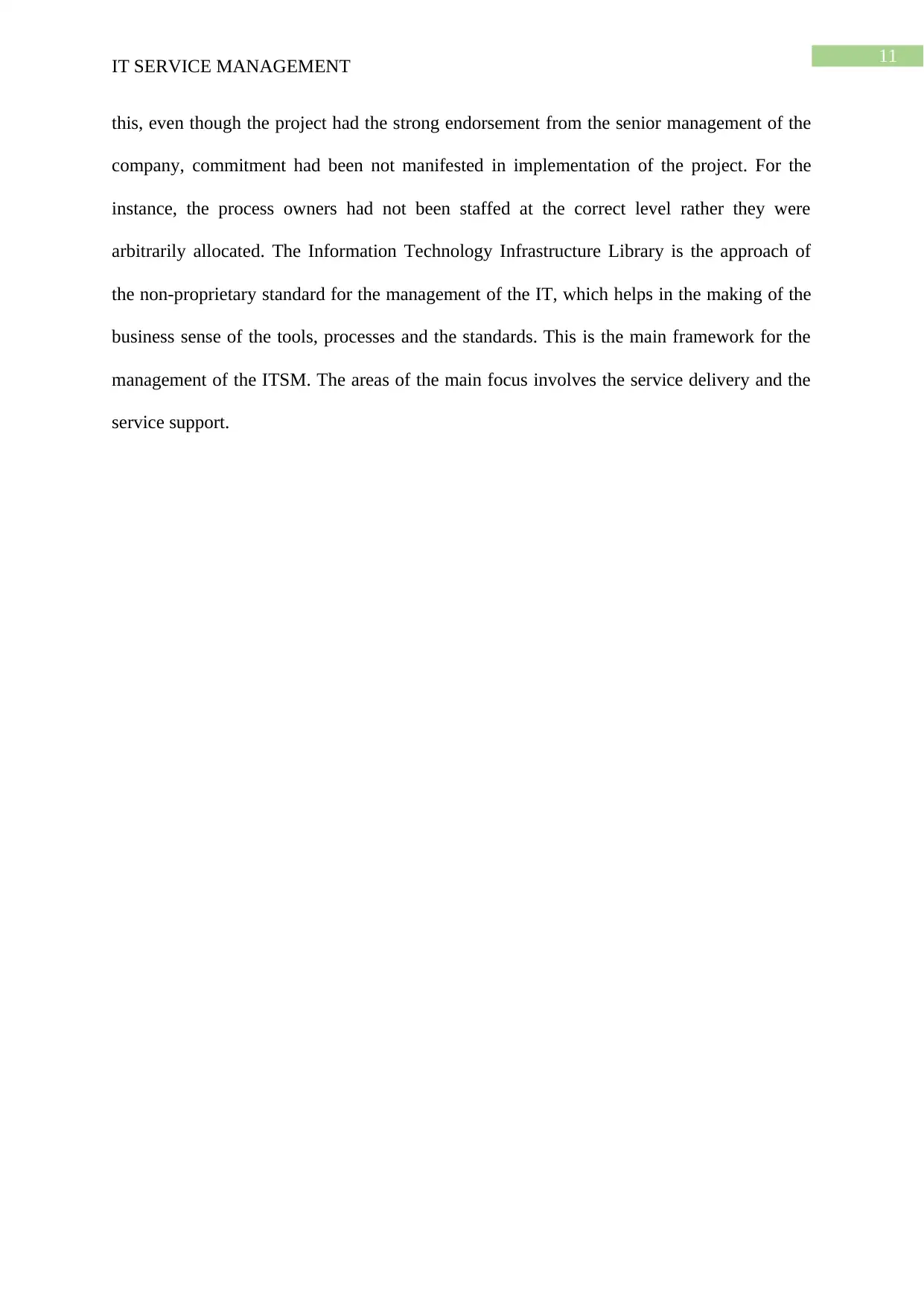
11
IT SERVICE MANAGEMENT
this, even though the project had the strong endorsement from the senior management of the
company, commitment had been not manifested in implementation of the project. For the
instance, the process owners had not been staffed at the correct level rather they were
arbitrarily allocated. The Information Technology Infrastructure Library is the approach of
the non-proprietary standard for the management of the IT, which helps in the making of the
business sense of the tools, processes and the standards. This is the main framework for the
management of the ITSM. The areas of the main focus involves the service delivery and the
service support.
IT SERVICE MANAGEMENT
this, even though the project had the strong endorsement from the senior management of the
company, commitment had been not manifested in implementation of the project. For the
instance, the process owners had not been staffed at the correct level rather they were
arbitrarily allocated. The Information Technology Infrastructure Library is the approach of
the non-proprietary standard for the management of the IT, which helps in the making of the
business sense of the tools, processes and the standards. This is the main framework for the
management of the ITSM. The areas of the main focus involves the service delivery and the
service support.
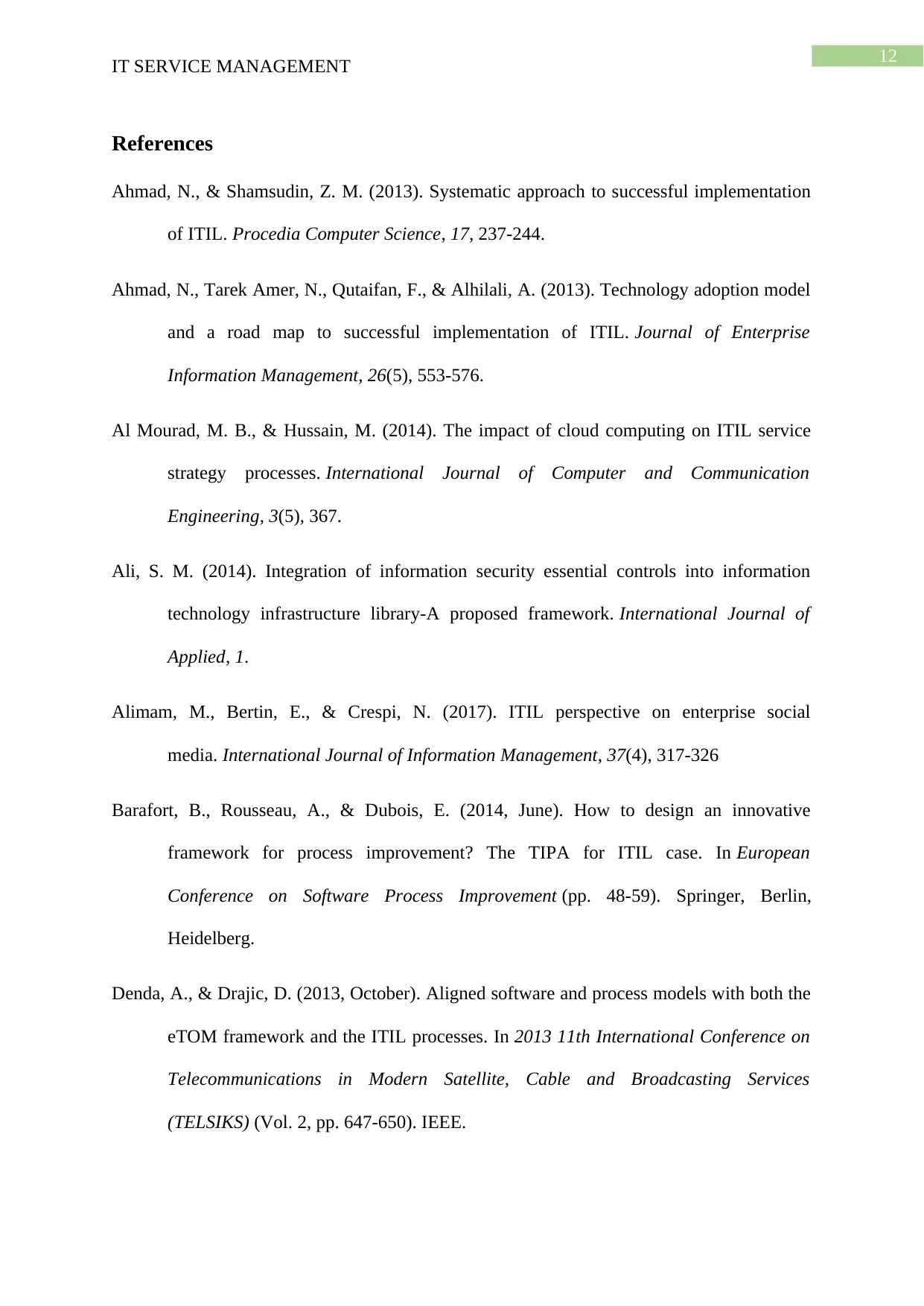
12
IT SERVICE MANAGEMENT
References
Ahmad, N., & Shamsudin, Z. M. (2013). Systematic approach to successful implementation
of ITIL. Procedia Computer Science, 17, 237-244.
Ahmad, N., Tarek Amer, N., Qutaifan, F., & Alhilali, A. (2013). Technology adoption model
and a road map to successful implementation of ITIL. Journal of Enterprise
Information Management, 26(5), 553-576.
Al Mourad, M. B., & Hussain, M. (2014). The impact of cloud computing on ITIL service
strategy processes. International Journal of Computer and Communication
Engineering, 3(5), 367.
Ali, S. M. (2014). Integration of information security essential controls into information
technology infrastructure library-A proposed framework. International Journal of
Applied, 1.
Alimam, M., Bertin, E., & Crespi, N. (2017). ITIL perspective on enterprise social
media. International Journal of Information Management, 37(4), 317-326
Barafort, B., Rousseau, A., & Dubois, E. (2014, June). How to design an innovative
framework for process improvement? The TIPA for ITIL case. In European
Conference on Software Process Improvement (pp. 48-59). Springer, Berlin,
Heidelberg.
Denda, A., & Drajic, D. (2013, October). Aligned software and process models with both the
eTOM framework and the ITIL processes. In 2013 11th International Conference on
Telecommunications in Modern Satellite, Cable and Broadcasting Services
(TELSIKS) (Vol. 2, pp. 647-650). IEEE.
IT SERVICE MANAGEMENT
References
Ahmad, N., & Shamsudin, Z. M. (2013). Systematic approach to successful implementation
of ITIL. Procedia Computer Science, 17, 237-244.
Ahmad, N., Tarek Amer, N., Qutaifan, F., & Alhilali, A. (2013). Technology adoption model
and a road map to successful implementation of ITIL. Journal of Enterprise
Information Management, 26(5), 553-576.
Al Mourad, M. B., & Hussain, M. (2014). The impact of cloud computing on ITIL service
strategy processes. International Journal of Computer and Communication
Engineering, 3(5), 367.
Ali, S. M. (2014). Integration of information security essential controls into information
technology infrastructure library-A proposed framework. International Journal of
Applied, 1.
Alimam, M., Bertin, E., & Crespi, N. (2017). ITIL perspective on enterprise social
media. International Journal of Information Management, 37(4), 317-326
Barafort, B., Rousseau, A., & Dubois, E. (2014, June). How to design an innovative
framework for process improvement? The TIPA for ITIL case. In European
Conference on Software Process Improvement (pp. 48-59). Springer, Berlin,
Heidelberg.
Denda, A., & Drajic, D. (2013, October). Aligned software and process models with both the
eTOM framework and the ITIL processes. In 2013 11th International Conference on
Telecommunications in Modern Satellite, Cable and Broadcasting Services
(TELSIKS) (Vol. 2, pp. 647-650). IEEE.
Paraphrase This Document
Need a fresh take? Get an instant paraphrase of this document with our AI Paraphraser
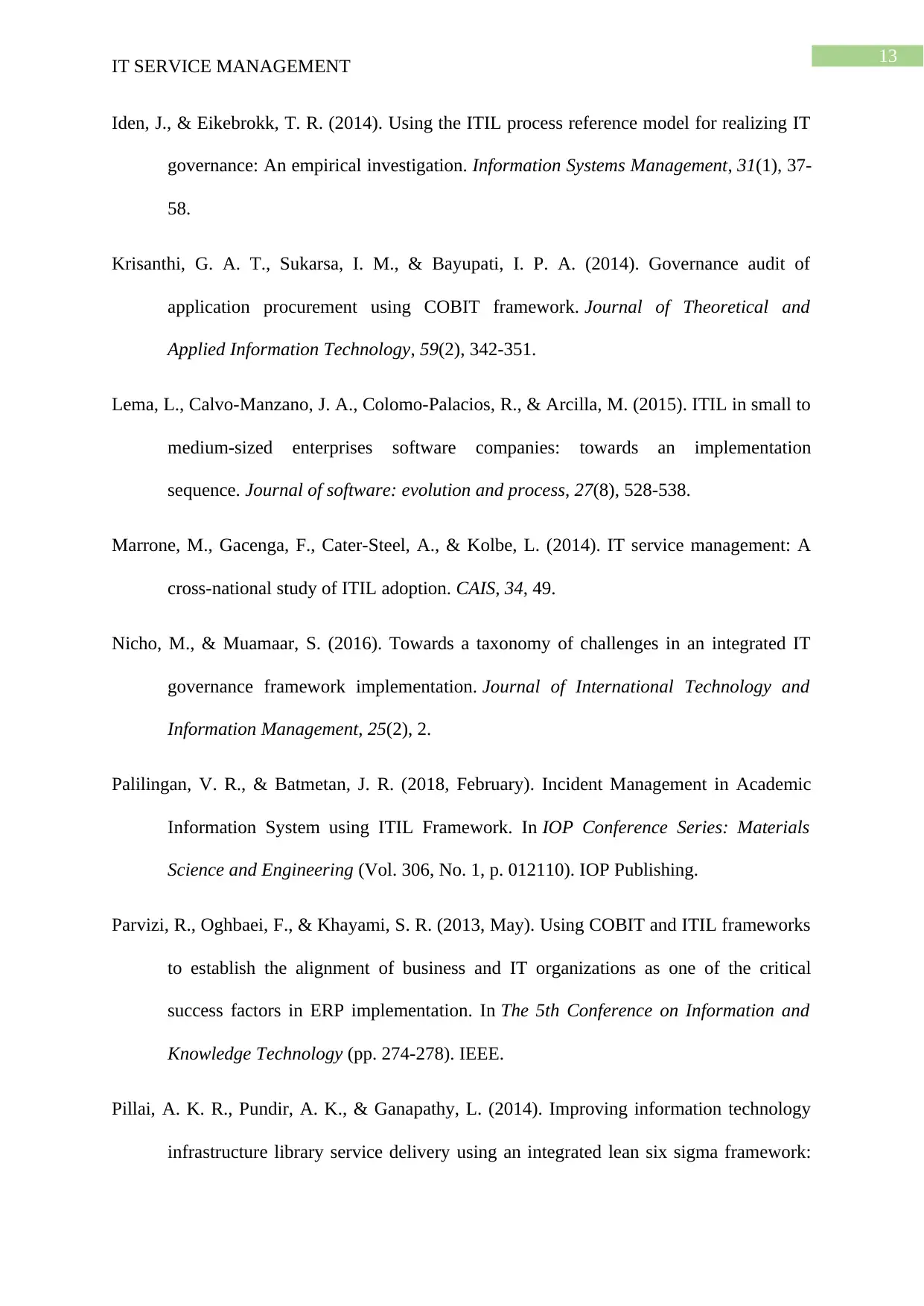
13
IT SERVICE MANAGEMENT
Iden, J., & Eikebrokk, T. R. (2014). Using the ITIL process reference model for realizing IT
governance: An empirical investigation. Information Systems Management, 31(1), 37-
58.
Krisanthi, G. A. T., Sukarsa, I. M., & Bayupati, I. P. A. (2014). Governance audit of
application procurement using COBIT framework. Journal of Theoretical and
Applied Information Technology, 59(2), 342-351.
Lema, L., Calvo‐Manzano, J. A., Colomo‐Palacios, R., & Arcilla, M. (2015). ITIL in small to
medium‐sized enterprises software companies: towards an implementation
sequence. Journal of software: evolution and process, 27(8), 528-538.
Marrone, M., Gacenga, F., Cater-Steel, A., & Kolbe, L. (2014). IT service management: A
cross-national study of ITIL adoption. CAIS, 34, 49.
Nicho, M., & Muamaar, S. (2016). Towards a taxonomy of challenges in an integrated IT
governance framework implementation. Journal of International Technology and
Information Management, 25(2), 2.
Palilingan, V. R., & Batmetan, J. R. (2018, February). Incident Management in Academic
Information System using ITIL Framework. In IOP Conference Series: Materials
Science and Engineering (Vol. 306, No. 1, p. 012110). IOP Publishing.
Parvizi, R., Oghbaei, F., & Khayami, S. R. (2013, May). Using COBIT and ITIL frameworks
to establish the alignment of business and IT organizations as one of the critical
success factors in ERP implementation. In The 5th Conference on Information and
Knowledge Technology (pp. 274-278). IEEE.
Pillai, A. K. R., Pundir, A. K., & Ganapathy, L. (2014). Improving information technology
infrastructure library service delivery using an integrated lean six sigma framework:
IT SERVICE MANAGEMENT
Iden, J., & Eikebrokk, T. R. (2014). Using the ITIL process reference model for realizing IT
governance: An empirical investigation. Information Systems Management, 31(1), 37-
58.
Krisanthi, G. A. T., Sukarsa, I. M., & Bayupati, I. P. A. (2014). Governance audit of
application procurement using COBIT framework. Journal of Theoretical and
Applied Information Technology, 59(2), 342-351.
Lema, L., Calvo‐Manzano, J. A., Colomo‐Palacios, R., & Arcilla, M. (2015). ITIL in small to
medium‐sized enterprises software companies: towards an implementation
sequence. Journal of software: evolution and process, 27(8), 528-538.
Marrone, M., Gacenga, F., Cater-Steel, A., & Kolbe, L. (2014). IT service management: A
cross-national study of ITIL adoption. CAIS, 34, 49.
Nicho, M., & Muamaar, S. (2016). Towards a taxonomy of challenges in an integrated IT
governance framework implementation. Journal of International Technology and
Information Management, 25(2), 2.
Palilingan, V. R., & Batmetan, J. R. (2018, February). Incident Management in Academic
Information System using ITIL Framework. In IOP Conference Series: Materials
Science and Engineering (Vol. 306, No. 1, p. 012110). IOP Publishing.
Parvizi, R., Oghbaei, F., & Khayami, S. R. (2013, May). Using COBIT and ITIL frameworks
to establish the alignment of business and IT organizations as one of the critical
success factors in ERP implementation. In The 5th Conference on Information and
Knowledge Technology (pp. 274-278). IEEE.
Pillai, A. K. R., Pundir, A. K., & Ganapathy, L. (2014). Improving information technology
infrastructure library service delivery using an integrated lean six sigma framework:
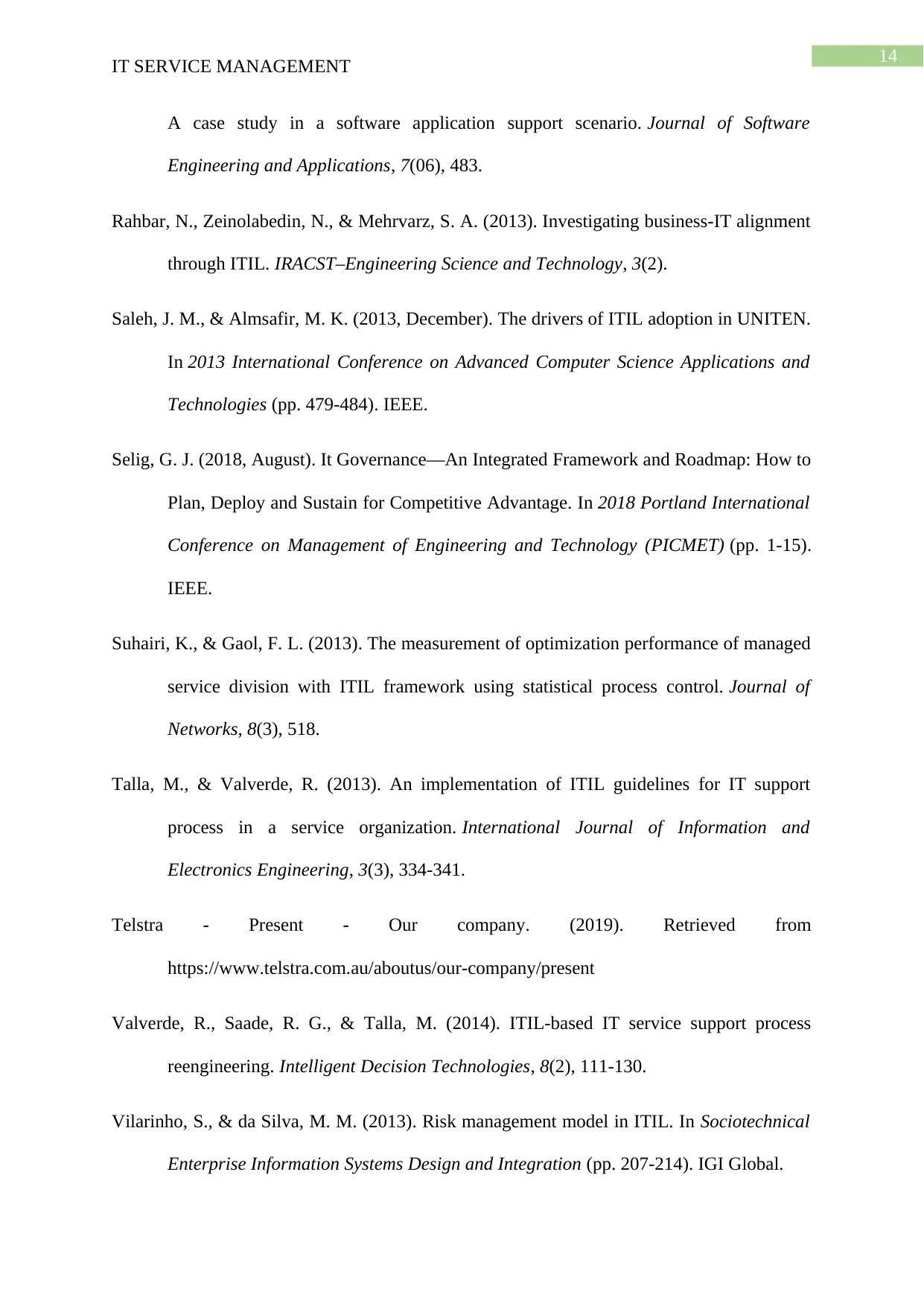
14
IT SERVICE MANAGEMENT
A case study in a software application support scenario. Journal of Software
Engineering and Applications, 7(06), 483.
Rahbar, N., Zeinolabedin, N., & Mehrvarz, S. A. (2013). Investigating business-IT alignment
through ITIL. IRACST–Engineering Science and Technology, 3(2).
Saleh, J. M., & Almsafir, M. K. (2013, December). The drivers of ITIL adoption in UNITEN.
In 2013 International Conference on Advanced Computer Science Applications and
Technologies (pp. 479-484). IEEE.
Selig, G. J. (2018, August). It Governance—An Integrated Framework and Roadmap: How to
Plan, Deploy and Sustain for Competitive Advantage. In 2018 Portland International
Conference on Management of Engineering and Technology (PICMET) (pp. 1-15).
IEEE.
Suhairi, K., & Gaol, F. L. (2013). The measurement of optimization performance of managed
service division with ITIL framework using statistical process control. Journal of
Networks, 8(3), 518.
Talla, M., & Valverde, R. (2013). An implementation of ITIL guidelines for IT support
process in a service organization. International Journal of Information and
Electronics Engineering, 3(3), 334-341.
Telstra - Present - Our company. (2019). Retrieved from
https://www.telstra.com.au/aboutus/our-company/present
Valverde, R., Saade, R. G., & Talla, M. (2014). ITIL-based IT service support process
reengineering. Intelligent Decision Technologies, 8(2), 111-130.
Vilarinho, S., & da Silva, M. M. (2013). Risk management model in ITIL. In Sociotechnical
Enterprise Information Systems Design and Integration (pp. 207-214). IGI Global.
IT SERVICE MANAGEMENT
A case study in a software application support scenario. Journal of Software
Engineering and Applications, 7(06), 483.
Rahbar, N., Zeinolabedin, N., & Mehrvarz, S. A. (2013). Investigating business-IT alignment
through ITIL. IRACST–Engineering Science and Technology, 3(2).
Saleh, J. M., & Almsafir, M. K. (2013, December). The drivers of ITIL adoption in UNITEN.
In 2013 International Conference on Advanced Computer Science Applications and
Technologies (pp. 479-484). IEEE.
Selig, G. J. (2018, August). It Governance—An Integrated Framework and Roadmap: How to
Plan, Deploy and Sustain for Competitive Advantage. In 2018 Portland International
Conference on Management of Engineering and Technology (PICMET) (pp. 1-15).
IEEE.
Suhairi, K., & Gaol, F. L. (2013). The measurement of optimization performance of managed
service division with ITIL framework using statistical process control. Journal of
Networks, 8(3), 518.
Talla, M., & Valverde, R. (2013). An implementation of ITIL guidelines for IT support
process in a service organization. International Journal of Information and
Electronics Engineering, 3(3), 334-341.
Telstra - Present - Our company. (2019). Retrieved from
https://www.telstra.com.au/aboutus/our-company/present
Valverde, R., Saade, R. G., & Talla, M. (2014). ITIL-based IT service support process
reengineering. Intelligent Decision Technologies, 8(2), 111-130.
Vilarinho, S., & da Silva, M. M. (2013). Risk management model in ITIL. In Sociotechnical
Enterprise Information Systems Design and Integration (pp. 207-214). IGI Global.

15
IT SERVICE MANAGEMENT
Zeinolabedin, N., Khademi, M., & Rahbar, N. (2013). Assessing Efficiency of ITIL
Framework to Align Business and IT. Research Inventy: International Journal of
Engineering and Science,, 5, 13-26.
IT SERVICE MANAGEMENT
Zeinolabedin, N., Khademi, M., & Rahbar, N. (2013). Assessing Efficiency of ITIL
Framework to Align Business and IT. Research Inventy: International Journal of
Engineering and Science,, 5, 13-26.
1 out of 16
Related Documents
Your All-in-One AI-Powered Toolkit for Academic Success.
+13062052269
info@desklib.com
Available 24*7 on WhatsApp / Email
![[object Object]](/_next/static/media/star-bottom.7253800d.svg)
Unlock your academic potential
© 2024 | Zucol Services PVT LTD | All rights reserved.





